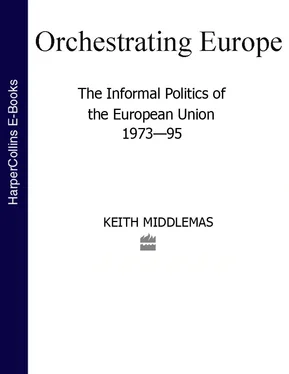The pursuit of the internal market centred on three consequential proposals: firstly, the Commission’s own report on regenerating industry, reforming CAP, and solving the budget issue (June 1981), secondly, the committee set up by the Council to draft amendments to the Treaties, to which were added, thirdly, the topics of strengthening the internal market, energy policy, industrial innovation and research, together with proposals on Mediterranean agriculture and job creation, especially among the young. These can be seen as preparatory to the November Council Meeting in London under the British Presidency. But the French also put alternative proposals in October, and in a parallel action, Genscher and Emilio Colombo submitted independently to Parliament in November a draft European Act and statement on integration.
The London Summit might therefore have been the occasion for renewal. That it was not can be attributed partly to Britain’s budget problem and partly to the principle of unripe time. 48Nevertheless, Mrs Thatcher became the first Prime Minister to address the Parliament, and a number of concessions were made to its demands for greater powers over the budget process. (These did not stop the Parliament threatening Council with ECJ proceedings in September 1982 for its failure to institute a common transport policy. The European Parliament now saw itself, conjoined with the Court, as one means eventually to subvert inter-governmental dominion.)
Meanwhile, exposed to the recession and confronted by the greater spectre of American and Japanese inroads into their markets, industries and businesses, especially the larger and multinational firms, began to campaign more publicly than in the past for a more effective industrial policy, and for the long-promised internal market. Until around 1981, these efforts had, with the exception of a small number of individual multinationals, largely been on a national scale, in the context of member states’ own industrial policies – or lack of them, 49but such was the divergence between German policy and the French socialist experiment, or between Britain’s deflationary neo-liberalism and Italian support for the state sector, that in 1981–3 they began to involve themselves more directly. As a result, influence tended to slip away from ministers, downwards towards the interest groups.
Lobbying of the Commission by industrial players became a notable feature during the Thorn Presidency, encouraged by some of the Directorates’ entry into more specialized policy-mongering, and by the appearance of contentious issues such as the Vredeling Directive on worker participation which required of companies large expenditure and sophisticated rebuttal techniques. Sectoral institutions across Europe in the chemicals and car industries, and the varying national peak bodies – CBI, DVI, Confindustria and Patronat – had for some years secured a point of leverage in DG3 (responsible for industry), particularly in Davignon’s day, though rather less so with his somewhat hide-bound successor, Karl-Heinz Narjes. But this had never generally obtained with the Commission, and to judge from British sources (the only ones currently available), 50they and their members had habitually resorted to their home governments, especially in Germany. They had enjoyed varying success. In France they were generally subordinated to an administrative definition of French interests. In Italy they had largely had to make their own way to Brussels. Furthermore, from a position of influence in the 1970s, in Britain after mid–1980 the CBI found itself isolated from government in a way unprecedented in post-War history – yet still having to defend UK membership on the UK political stage, as if it were an open issue. 51(Operations of these networks are considered in chapter 10.)
In spite of the problems which national peak organizations encountered at home, their European counterpart UNICE was not their preferred choice for activity when it came to trying to influence the Council of Ministers or the Commission. 52On the one hand, their members could use the sectoral bodies which already represented each industry; on the other, they could form new organizations of leading industrialists, such as the European Round Table or the group around Guido Carli, governor of the Bank of Italy, which included important heads of banks such as Alfred Herrhausen (Deutsche Bank). The heads of large companies, many of them French, members of AGREF, the association of larger, private sector companies, notably less protectionist and conservative in their own outlook after Mitterrand’s 1983 turnabout, now looked to links with MEPs in the Parliament, such as the Kangaroo group, or developed their own specific companies’ commercial strategies: of which the Albert Report and Wisse Dekker’s report on behalf of Philips (Netherlands) are prime examples.
But whatever the mode of activity (which in the case of national organizations frequently overlapped), the central issues remained the same: abolition of non-tariff barriers and establishment of the internal market. The CBI’s European Steering Committee had indeed held this in its sights continuously from as early as August 1974, and from March 1977 was working closely with the French Patronat. Again, if it is fair to generalize from CBI records, governments used these peak organizations to achieve similar national ends, which in itself encouraged them to address Brussels more directly. 53But on the whole, these semi-public efforts took care to keep industry’s initiatives free of the political vortex during the confused infighting among member states in the period 1979–83.
Much of the industrialists’ work overlapped. Wisse Dekker remained a leading member of ERT while drafting his report, Europe 1990, with Philips’ backing. According to the CBI, 90% of their proposals coincided with his. Europe 1990 also foreshadowed the internal market White Paper in 1985, but since it was begun in the recession under the guidance of firms in the front line of exposure from American and Japanese competition, it was set in a defensive mode, tinged with protection. Fears of the social consequences of 10–12 million unemployed at a time when trades unions’ bargaining strengths in Brussels appeared to be reviving, conditioned its aims of reducing costs without hitting either wages or salaries. So many Ministries of Labour, Commission officials and MEPs felt soured by the way that the Vredeling Directive had been emasculated by a combination of industrial federations, UNICE, and the American Chamber of Commerce’s European Committee, 54that they were prepared to listen to ETUC arguments about the ‘transaction costs’ of ignoring the social partners – that is, predisposed to avoid electoral unpopularity and industrial relations conflict.
The CBI (which had fought Vredeling all the way with support from its government and Conservative MEPs) could see that its 10% divergence from the Dekker Report lay not only in its labour market policy but in important questions about how to address all non-tariff barriers together, how to incorporate financial markets, and how far to liberalize and deregulate, rather than erect new barriers where the Euro-borders met the outside world. How effective all this was in the general array of influence bearing on the Single European Act in 1985 is a question for the next chapter: here it should be noted that it aroused the interest of all the allies against Vredeling, among American firms, in the long-established European Committee of AmCham, and also among Swiss firms such as Nestlé and Ciba-Geigy, which were already habituated to working in the EC.
Older pressure groups joined in, under new banners: Jean Monnet’s Action Committee, which he had dissolved in 1975, was refounded in 1979 by Leo Tindemans and Max Kohnstamm, primarily to campaign for European union, but it included industrialists whose main interest was the internal market. When in the second half of 1982 the European Parliament produced a resolution for European Union, the Commission responded with its own proposals for reinforcing the internal market. At the Copenhagen Summit in December, heads of government were finally persuaded to call on the Council of Ministers ‘to decide on the priority measures to reinforce the internal market’. 55
Читать дальше









![Brian Thompson - A Monkey Among Crocodiles - The Life, Loves and Lawsuits of Mrs Georgina Weldon – a disastrous Victorian [Text only]](/books/704922/brian-thompson-a-monkey-among-crocodiles-the-life-thumb.webp)


